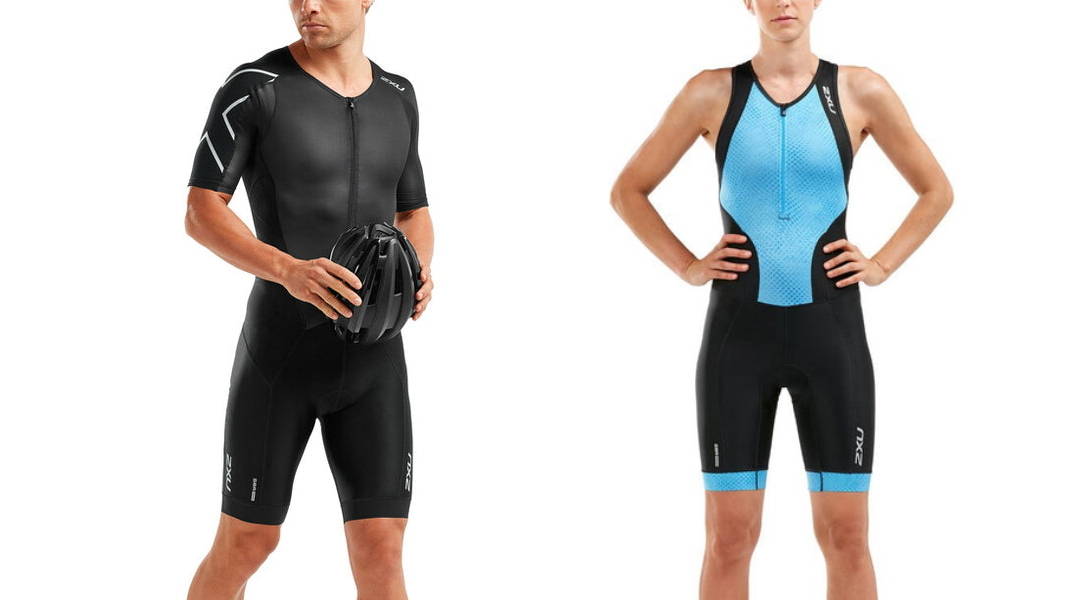Ein Triathlon-Einteiler begleitet den Athleten meistens mehrere Stunden lang durch den Wettkampf und muss deshalb allen Anforderungen des Schwimmens, Radfahrens und Laufens gewachsen sein. In diesem Artikel zeigen wir euch, was einen guten Trisuit ausmacht und worin die wesentlichen Unterschiede zwischen verschiedenen Trisuit-Varianten bestehen.
Mit oder ohne Ärmel?
- mit Ärmel bietet mehr Sonnenschutz beim Radfahren und Laufen am Rücken und über die Schultern
- mit Ärmeln = verbesserter aerodynamischer Effekt, da die Anzüge zumeist als "Aerosuits" konzipiert werden
- ohne Ärmel = mehr Bewegungsfreiheit im Schulterbereich, v.a. wichtig beim Schwimmen
Je nach Rennen gibt es Richtlinien, die ein Anzug erfüllen muss, jedoch ist die Wahl des Trisuits eine reine Geschmacksfrage.
Doch was zeichnet nun einen guten Trisuits aus?
1. Material des Anzugs
Die Oberfläche des Trisuits ist wichtig für den Wasser- und Luftwiderstand. Hochwertige Trisuits bieten eine bessere Aero- bzw. Hydrodynamik. Wird beim Schwimmen ein Neo über dem Anzug getragen, so spielt das Textil für den Wasserwiderstand keine Rolle. Der wichtigste Aspekt ist jedoch der Feuchtigkeitstransport. Die Stoffe von hochwertige Trisuits transportieren die Feuchtigkeit schneller nach außen. Bei Kälte bleibt der Körper länger warm, da der kalte Schweiß abtransportiert wird. Im Sommer verdunstet die Feuchtigkeit und kühlt den Körper. Dadurch wird die Körpertemperatur bei jedem Wetter optimal reguliert.
2. Sitzpads
Die Sitzpads in Ein- oder Zweiteilern sind deutlich kleiner und dünner als in normalen Radhosen. Das hat den Grund, dass im Triathlonwettkampf mit den Trisuits das Schwimmen und Laufen bewältigt werden muss. Eine dicke Polsterung im Anzug würden sich beim Schwimmen vollsaugen und beim Laufen die Beinfreiheit des Athleten einschränken. In hochwertigen Anzügen ist ein schnelltrocknender und antibakterieller Einsatz vernäht, damit das Pad auch nach vielen Wettkampfstunden nicht zum "Störfaktor" wird.
3. Nähte und ReißverschlussS
Da der Trisuit im Wettkampf nicht immer behutsam angefasst wird, sollten die Nähte und der Reißverschluss auch belastbar sein. Ebenfalls sehr wichtig, die Verarbeitung der Nähte. Denn durch die enge Passform des Trisuits kann eine schlecht verarbeitete Naht auf der Haut sehr unangenehm werden. Hier macht sich der Unterschied zwischen den unteren und oberen Preisklassen deutlich bemerkbar. Häufiges Problem: Hautreizungen und Scheuerstellen. Meistens ist das eine Kombination aus Reibung, Feuchtigkeit und schlechter Materialverarbeitung. Der Trisuits sitzt eng, sollte jedoch nie kratzen, den Torso einengen oder die Schulter- und Beinfreiheit einschränken.
Die Teilnahme an Wettkämpfen ist meistens das Ergebnis monatelanger Arbeit. Hier geht es darum, die Topform abzurufen und die harten Trainingseinheiten mit einer guten Wettkampfzeit zu belohnen. Hierbei sollte die Ausrüstung den Athlet unterstützen und nicht durch mangelnde Qualität zum Störfaktor werden.




















